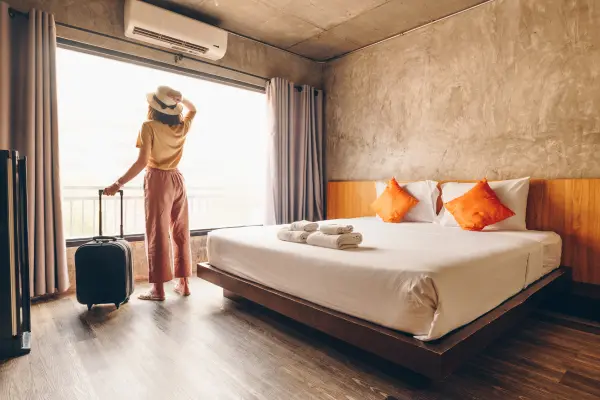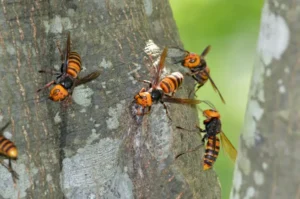
Pests can find their way into your hotel in a variety of ways. While some entry points are easy to spot, such as doors that are left open or not properly sealed, others are far less noticeable. Once inside, pests can spread quickly, leading to potential health risks, property damage, and negative guest experiences. For effective prevention and control, it’s always a good idea to consult a pest control expert who can help identify vulnerabilities and provide tailored solutions.
These are the main entry points pests use in hotels, and the steps you can take to block them:
Dumpster Compactors
Dumpster compactor chutes can become entry points for pests when their designs are poorly sealed. Additionally, dumpsters themselves often attract pests and provide ideal breeding grounds. If not properly maintained, these dumpsters can harbor fly maggots and other insects, allowing them to thrive inside.
The way dumpsters are handled also plays a role in pest spread. When an old dumpster is dropped off at a waste site and replaced with a new one, it can inadvertently transport pests along with it. That’s why it’s crucial to monitor these areas carefully. Facilities should implement regular cleaning programs for dumpsters and dumpster pads, especially during warm months. Interior doors to compactor chutes should remain closed when not in use to prevent pest entry.
Guests
Guests and their luggage can unintentionally introduce pests like bed bugs into a facility. This is a common way infestations start. It’s vital to train hotel employees to spot the early signs of bed bugs so infestations can be managed promptly. Bed bug monitors and professional inspections offer valuable tools to assist an observant staff.
Employees
Pests like German cockroaches and bed bugs often use employees’ belongings as vehicles to infiltrate workplaces. To minimize this risk, it’s vital to offer a separate, secure area where employees can store personal items, including food and clothing.
Keeping a close eye on these storage areas through regular monitoring and locker clean-outs is critical. Additionally, facilities should create clear policies for responding when employees are identified as sources of pests. These policies should be developed ahead of time and may require involvement from multiple departments, including HR.
Incoming Shipments
Just as pests can hitch a ride on employees, they can also sneak in on food, linens, and other materials delivered to your building. Careful inspection of all incoming goods is essential to prevent these unwanted hitchhikers from entering your facility.
Once items are accepted on-site, it becomes challenging to determine who is responsible for any resulting infestations. Common pests transported with shipments include rodents, cockroaches, and stored product pests. Even tiny flies can arrive on fresh fruits and vegetables, and bed bugs have been known to travel on laundry carts.
Negative Building Pressure
Negative pressure in a building is a costly problem to correct but is often responsible for allowing many insects to enter. In extreme cases, the force of outdoor air pressing against doors can make them very difficult to open.
This negative pressure effect can suck insects inside regardless of their intention. The issue becomes even more complex when combined with lighting that attracts insects, warm indoor temperatures, and food smells emanating from the structure.
Improperly Functioning Air Doors/Curtains
When it comes to keeping pests out, air curtains can sometimes mislead facility managers if the wrong unit is selected or if maintenance is neglected. These devices may deteriorate in performance over time or be improperly set up initially.
Proper air curtains deliver a 2 to 5-inch wide air stream at the nozzle, with an air velocity of at least 1600 feet per minute measured 3 feet above the floor and across the door’s width. Facilities should routinely inspect their air doors to ensure they work properly. Incorrectly functioning air curtains may pull insects inside instead of keeping them out. The airflow must be directed outward, away from the building, for optimal protection. Negative pressure inside the building is a critical factor in selecting the right air curtain, as it can reduce effectiveness.
Dock Plates
Because dock plates must accommodate movement, gaps around them are common. The best dock systems feature plates that fold down from an upright position into the trailer, instead of being built flush with the floor.
When dock plates are integrated into the floor, spaces around them must be sealed with brushes or plates. It is important to ensure a tight seal where the dock plate and door seals meet. Regular inspections of dock plate wells are necessary to detect product spills and pest activity. Exterior gaps and chain pull openings in these wells can serve as pest entry points. Various sealing options, such as those offered by Xcluder, help prevent pests from entering through these vulnerable areas.
Improperly Functioning Automatic Doors
Automatic doors are commonly used in hotels to provide convenient access for guests. However, if these doors are not regularly inspected, they may remain open longer than needed or even stick open.
It’s important to check the operation and timing of all automatic doors, including both inner and outer vestibule doors, as they play a critical role in pest prevention. Doors that malfunction or stay open can allow pests to enter. Revolving doors offer better protection against pests and generally require less maintenance related to timing and pest control.
Floor Drains
Sewer systems can provide ideal hiding spots for pests including small flies, cockroaches, and rats that may then enter our facilities. Drains not frequently used for managing water flow can be particularly vulnerable to pest activity.
Maintaining these drains through routine cleaning and installing proper grates is essential for preventing pest migration through sewer routes. If a drain isn’t necessary for wastewater, consider sealing it. When a drain is needed but allows pests in, specialized caps or screened covers, sometimes called “socks,” can allow water flow but block pests. Products like the Liquid Breaker Green Drain offer insect-specific exclusion through a one-way valve.
Staying One Step Ahead of Hotel Pests
Pests can enter a hotel through many different routes, from dumpsters and dock plates to employees and guests. By understanding these common vulnerabilities and implementing thorough inspection, maintenance, and exclusion measures, hotels can greatly reduce the risk of pest intrusion.
Keep your hotel safe from pests. Call Batzner Pest Control today and protect your business!
Need a pest control estimate?
We'll call you! Our representatives are fast and friendly.
Preventing Pest Entry in Hotels in Wisconsin
Serving Wisconsin





